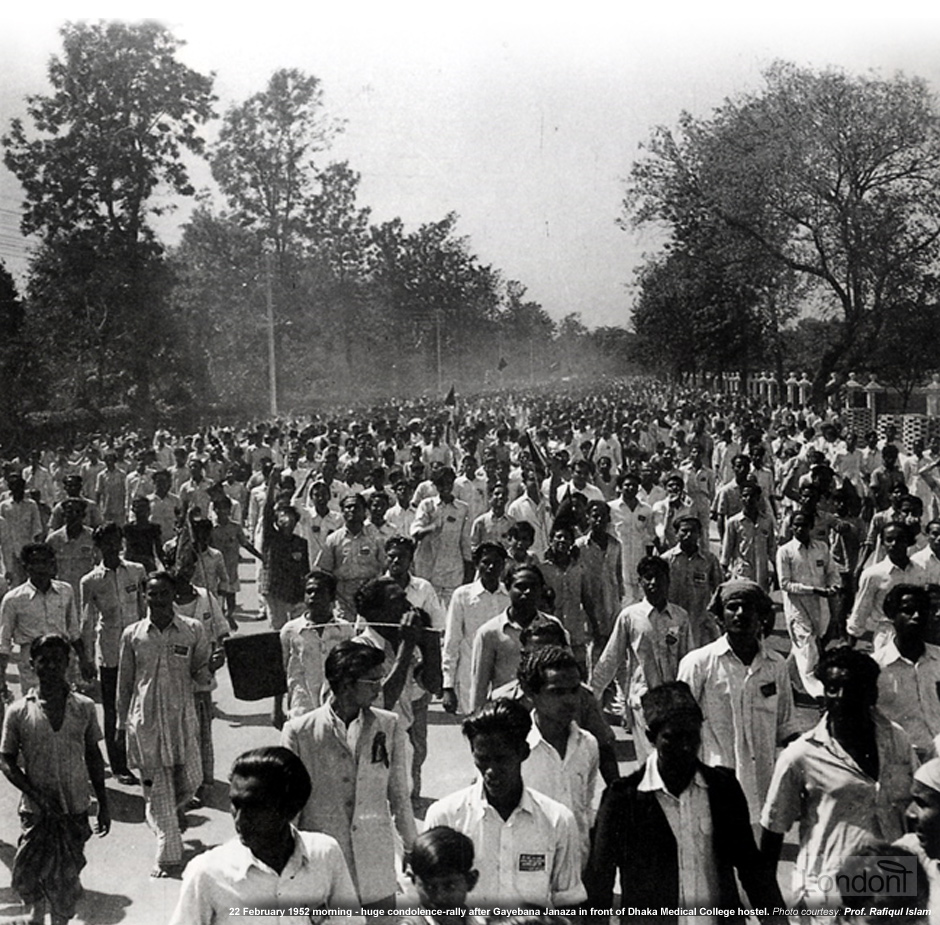
Student and intellectual movement transformed into a mass movement
Last updated: 5 October 2017 From the section 1952 Bhasha Andolon
Though the language agitation had not attained its immediate objective, it however produced certain inevitable consequences. First, it generated a mass movement secular in character. Second, it enlisted the sympathy and support of a wider section of the masses. Thirdly, it cut across all political and religious barriers and penetrated into the heart of every citizen.
It was not urban in character. Those who played an effective role in conducting the movement came from the rural peasantry. Finally, it induced East Bengal to think that the Bengali interests were not safe in the hands of the Muslim League Government dominated by the West Pakistanis. The East Bengal language agitation left an imprint on the minds of the people who decided to observe 21 February as a Shaheed Dibosh (Martyrs Day).
All the victims shared a Bengali identity, a point that is highlighted at each annual Ekushey observance. The student of the medical college erected a Shaheed Minar (Martyrs' Column) on the night of 23 February 1952 at the spot where one of their friends, Barkat, was shot dead. Maulana Bhashani along with Abu Hossain Sarker, chief minister of the then East Bengal and mother of martyred Barkat laid the first foundation stone of Shaheed Minar. This monument was to become the rallying point for Bengali nationalism. Three days later, the police demolished the memorial.
The tragic 1952 events rallied Bengalis around a common purpose: the protection and preservation of their culture as exemplified in the monument, the commemorative events, and the activities inspired by the clashes with police.
The Language Movement affected the Bengalis as a people; a latent cultural nationalism was fused to a political cause and the common bond stimulated a politically conscious public. The people of Bengal had something they all believed in; in fact could fight and die for. Irrespective of the narrow patriotism it created, it propelled the Bengali on the road to political maturity.
For subsequent 3 to 4 days after Ekushey February, Dhaka turned into a city of demonstrations and processions by thousands of people chanting angry slogans against police atrocities, although curfew was still in force. Shops stayed closed and no vehicles were seen on the streets of Dhaka. Railway workers stayed away from work, which meant that trains did not leave Dhaka or enter it. Clashes between citizens and the police were reported from various parts of the city. Despite a heavy presence of police and soldiers on the streets, thousands of Bengalis poured out to condemn the government over the killings of February 21. Women students of Dhaka University, besides their male fellow students, came together to condemn what they called the barbaric act of the government. Hartal was observed all over the province and various organisations issued statements severely condemning the police action of 21st February, whilst the students demanded the resignation of the chief minister Nurul Amin.
Prominent activists arrested and jailed
As February 23 drew to a close, the Tamaddun Majlis issued a statement severely criticizing the action of the government. It resolved to continue the struggle for Bangla as the language of the state.
The Weekly Sainik [newspaper] brought out special issue on 22 February. As all the copies were exhausted soon, it had to go for 2nd and 3rd editions on 23 February with reporters on the latest situation.
Most of the leaders went into hiding as police had been frantically trying to arrest them. Within two weeks from the nightfall of 23 February 1952 most of the members of the Committee of Action and other leaders of the Movement including Maulana Bhashani, Abul Hashim, Shamsul Huq, Kazi Golam Mahbub, Khairat Hossain, Oil Ahad, Abdul Matin, Mirza Golam Hafiz, Khandakar Moshtaq Ahmad, Mohammd Toaha, Khaleq Nawaz Khan, Aziz Ahmad, etc. were arrested. At about 3am in the night following 23 February 1952 police surrounded the office of Tamaddun Majlis at 19 Azimpur in order to arrest Prof. M.A. Quasem and Abdul Ghafur, but they were able to go out of the office and escape arrest.
The next few days brought violence and agitation. The state’s coercive power was used against the protestors again and again. For their part, the protestors too went to the extreme: government installations were stoned and offices of the Morning News, which had always opposed Bengali, were burnt. The government responded by arresting prominent anti-government politicians and intellectuals.
Ekushey February created myths, symbols and slogans... It gave Bengalis not only a popular common cause but also their first martyrs.
Michael E. Brown & Sumit Ganguly, Editors of "Fighting Words: Language Policy and Ethnic Relations in Asia" (2003)
